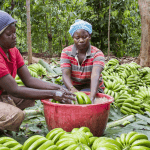Beyond Risk: How Addressing Transaction Costs Can Boost Lending to Agricultural SMEs in Africa
Editor’s note: This is the third article in a series from Aceli Africa, exploring challenges and solutions in agricultural investing in Africa. Part one of the series highlighted the disconnect between the unattractive lending economics and the need for private investment to achieve development goals in African agriculture. Part two focused on how blended finance approaches that are data-driven, impact-linked and marketplace-level could bridge this gap. The article below shares perspectives from lenders in the region and unpacks Aceli’s data findings, particularly those that illustrate the under-recognized role of high transaction costs in limiting capital flows for African agricultural small and medium enterprises (SMEs).
“By the time we got there, our car looked like we’d finished a rally race. You have to be a bushman to do this work.” Robert Lukumay, investment manager for the Tanzanian impact lender SME Impact Fund (SIF), was recounting his journey to visit SIF’s newest borrower in northwest Tanzania. The drive usually takes a day and a half from SIF’s office in Arusha — but this time, the gearbox mounting on his car broke off on the bumpy roads, adding an extra day and a half. “But it was worth it,” he continued. “That business has a lot of potential.”
The job of an agricultural loan officer isn’t glamorous. It involves hours behind the wheel in the glaring sun, dingy guesthouses and roadside “toilets.” And that’s just to reach the business to decide if it’s worth trying to underwrite the loan.
After the long drive home, a more arduous journey begins: the effort to get the loan approved. A loan officer from a Kenyan bank broke it down this way: “For agri, there’s a second set of questions [on top of the normal business analysis], where the risk team asks what is happening in the macro environment in terms of global prices, weather and production risk; how much of the product spoils from farm to market, etc. The field visits and due diligence take much longer [than for other sectors], and then I still have to get the loan past the risk team.”
In Aceli’s survey of agricultural lenders in East Africa, we found that a typical loan officer in a non-agriculture business unit can handle 1.7 times as many loans as a loan officer focused on agriculture. Serving new borrowers or new value chains adds more expense — as much as a 50% increase in origination costs due to the extra time required. These elevated costs explain why so many lenders are reluctant to serve agri-SMEs at all — or why they focus narrowly on certain crops and regions that are close to their offices. With limited access to finance, the growth and impact of agri-SMEs is stunted: They purchase less from smallholder farmers, employ fewer workers, supply lower volumes of nutritious foods to consumers, and do not realize their potential to drive inclusive economic growth.
Barriers to agri-SME lending: risk and cost
There’s been a longstanding debate in the agricultural finance sector about whether lending risk in agriculture is real or perceived. Aceli’s findings from data on 9,000+ loans to agricultural SMEs across 31 lenders indicate that risk in lending to agricultural SMEs is at least two times higher than risk in other sectors. And this only accounts for the loans that are being made. We expect that risk is significantly higher in segments of the agricultural market that are less served.
When we asked lenders about the biggest barriers to serving agricultural SMEs, we weren’t surprised that higher risk was the top response. But a close and often-overlooked second was the higher operating costs of serving agri-SMEs. Aceli’s data on the economics of agri-SME lending suggests that higher transaction costs (e.g., the additional time for travel and risk analysis) may account for as much as half of the 4-5% return gap between agri-SME lending and lending to other sectors in East Africa.
High transaction costs also explain why many lenders that come into the market with the intention of serving the missing middle with loans under $1 million gravitate to the $2-5 million+ range over time. For smaller loans, particularly those under $500,000, Aceli’s data indicates that lenders would have to double their interest rates — which in many cases are already cost-prohibitive for low-margin businesses in the agriculture sector — to be able to cover their expenses and earn an acceptable return.
A natural question is whether there are better business models for delivering credit to agricultural SMEs at lower costs. After all, technology has disrupted the financial services sector in countries like Kenya, where over 50% of the GDP flows through mobile money apps such as M-PESA. However, applying technological innovations to agri-SME lending has proven more difficult. This is particularly true in Aceli’s focus range of $25,000–$1.5 million loans, where the relatively small number of enterprises (numbering in the hundreds or low thousands compared to millions of consumers), the high degree of heterogeneity among these enterprises, and the lack of reliable financial records are impediments to big data approaches. Simply put, the economics of agri-SME lending haven’t attracted innovation, as more lucrative opportunities exist for tech innovators.
Over the next decade, technology can and must play a greater role in lowering transaction costs for agri-SME lending (e.g., data-driven credit scoring, satellite imagery that reduces the need for in-person field visits). Aceli is collaborating with Alliance for a Green Revolution in Africa to promote innovative business models and accelerate this process. Public sector investment in roads, ports, and electricity to power agri-processing facilities and the cold chain for perishable food is also essential. But technological innovation and infrastructure investments take time; solutions for mobilizing lending for agri-SMEs are needed immediately.
Syncing financial returns with development impact
The primary approach taken by donors to increase agri-SME lending in Africa — loan guarantees covering 50% of the lender’s exposure — focuses solely on the risk side of the loan profitability equation and may only address one-fourth of the lender’s opportunity cost relative to more lucrative sectors. Aceli’s product offering, by contrast, is designed to address the full profitability gap so that lenders can earn a return on their agri-SME lending that is comparable to other sectors. Importantly, Aceli’s incentives address both risk (through a portfolio first-loss approach explained here) and transaction costs. We believe solving for high transaction costs in agri-SME lending is crucial and under-addressed in most blended finance approaches to stimulate lending for SMEs — and this is particularly true for agricultural SMEs.
Aceli addresses the transaction cost barrier by offering “origination incentives” for every qualifying agri-SME loan of $25,000 – $500,000 made by SME Impact Fund and our 25 other lending partners in East Africa. These origination incentives supplement the income earned from interest and fees on the loan by providing additional revenue to the lender — typically 5-10% of the loan value (and up to 14% for smaller loans) — to compensate for the time it takes to visit borrowers in remote areas, prepare credit memos for SMEs that rarely have audited accounts, and manage these loans through unpredictable weather and market conditions.
Similar “Pay for Impact” or “Pay for Results” models have targeted transaction costs to increase access to services and finance for underserved populations in other sectors and geographies. Social Impact Incentives (SIINC) is one such approach that was initially developed by Roots of Impact and the Swiss Agency for Development and Cooperation (SDC) to align impact and financial sustainability for social businesses. For example, Clínicas del Azúcar is a Mexican company that treats diabetic patients. The SIINC mechanism, funded by SDC and the Inter-American Development Bank (IDB), rewards Clínicas for serving low-income patients that cannot afford to pay as much and are therefore not as profitable as middle-income patients.
Root Capital (where I previously served on the leadership team) partnered with Roots of Impact, SDC and IDB to adapt this approach to incentivize high-impact but unprofitable lending by Root Capital to agricultural SMEs in Latin America. With support from SDC, USAID and IKEA Foundation, Aceli further iterated on the model by applying it to a marketplace of 25+ lenders in Africa. Aceli’s origination incentives are calibrated based on the data of agri-SME lending economics that we gathered: They effectively create a market price so that lenders compete on a level playing field to make loans that are high-impact but not otherwise profitable. Aceli periodically adjusts the incentives as the market becomes more competitive, so that limited donor funding can be leveraged for maximum impact.
This brings us back to Robert Lukumay, the SIF investment manager whose car broke down en route to visiting a prospective client. Four weeks after he returned from his trip, SIF’s investment committee approved a $43,000 loan to a business that purchases rice from 150 smallholder farmers, employs 12 workers at its processing facility and sells to local consumers — all in a remote region of Tanzania where there is little formal employment, and the only financial services are two mobile bank branches on wheels that roll through collecting deposits once a month. Aceli will pay SIF an origination incentive of $5,160 to make this loan.
Now that SIF has identified one client in the region, Lukumay explained that he’s meeting other businesses in the same area and plans to develop a cluster of investments. Over the next few years, he expects that these businesses will grow and become profitable for SIF to serve (so that it no longer needs Aceli’s incentives), while purchasing larger volumes from smallholder farmers, generating increased employment and selling more food to Tanzanian consumers. As the local economy grows, the mobile banks that now collect deposits once a month will soon be offering loans and opening up branches in the region. And by that time, the roads might be just a bit smoother for Lukumay’s commute.
Brian Milder is the Founder and CEO of Aceli Africa.
Photo: Robert Lukumay standing next to his broken-down car. Photo courtesy of Robert Lukumay.
- Categories
- Agriculture, Investing
- Tags
- impact investing, lending



